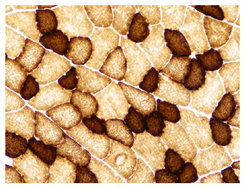One for two
A new mouse model developed to study mitochondrial DNA replication allows insights into mechanisms of mitochondrial diseases and the ageing process.

Our body gains energy required for all cell biological processes from its own powerhouse, the cell organelle called mitochondrion. In contrast to the most other cell organelles, mitochondria possess their own genetic material, mitochondrial DNA (mtDNA) whose accurate synthesis is an essential process to ensure proper mitochondrial function. The protein MGME1 (Mitochondrial Genome Maintenance Exonuclease 1) is responsible for proper synthesis of mtDNA. Recently, it was reported that some mitochondrial disease patients carry mutations in the MGME1 gene leading to severe disease symptoms like skeletal muscle wasting, cardiomyopathy, respiratory distress, mental retardation and others.
Scientist from the Max Planck Institute for Biology of Ageing in Cologne created a knockout mouse model for MGME1, which allows them to characterize the protein and the consequences of its dysfunction. They discovered that like in humans with mitochondrial disease, where the function of muscle and brain cells are often severely disturbed while other organs remain almost completely healthy, the lack of the MGME1 protein also affects specific tissues differently. However, this tissue specificity as a consequence of mitochondrial disorders is poorly understood. The scientists hope that with this new mouse model they have found an important tool for future research aiming to understand the mechanism of mitochondrial disease.
While analyzing the MGME1 knock out mice, the scientists discovered the presence of mitochondrial DNA fragments that have been previously found in another mouse model, called mutator mouse that exhibits severe ageing symptoms. For years it was debated if those fragments are contributing to ageing. However, the new MGME1 mouse model does not show early ageing symptoms thus disconnecting this phenomenon as a hallmark for ageing.
Those findings are just the tip of an iceberg. The new mouse model will help to resolve the role of mitochondria in ageing and serve as a valuable tool for the future studies on mitochondrial diseases.
Read more about the research in Nils-Göran Larssons lab here.












